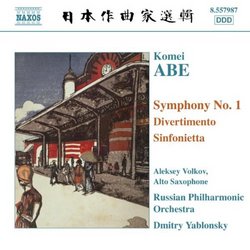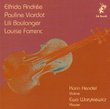| All Artists: Komei Abe, Dmitry Yablonsky, Russian Philharmonic Orchestra Title: Komei Abe: Symphony No. 1; Divertimento; Sinfonietta Members Wishing: 0 Total Copies: 0 Label: Naxos Original Release Date: 1/1/2007 Re-Release Date: 12/11/2007 Genre: Classical Styles: Forms & Genres, Concertos, Symphonies Number of Discs: 1 SwapaCD Credits: 1 UPC: 747313298723 |
Search - Komei Abe, Dmitry Yablonsky, Russian Philharmonic Orchestra :: Komei Abe: Symphony No. 1; Divertimento; Sinfonietta
 | Komei Abe, Dmitry Yablonsky, Russian Philharmonic Orchestra Komei Abe: Symphony No. 1; Divertimento; Sinfonietta Genre: Classical
|
Larger Image |
CD DetailsSimilar CDs
|
CD ReviewsConservative Japanese Orchestral Works Ralphus | Goyang, Gynggi-Do Korea (South) | 01/28/2009 (3 out of 5 stars) "Komei Abe was born in Hiroshima in 1911, into a period of 'Westernisation' in Japanese culture and art. This disc offers us his Symphony no.1, Sinfonietta, and Divertimento for Saxophone. Abe's early musical influences were of Western style marches, violin music and dance bands. The booklet notes tell us that he had very little knowledge of traditional Japanese music until he made the effort to study it in later years. He studied cello and composition at the Tokyo Music School under primarily German teachers. Thus, specific influences from European classical music came from Mahler, R.Strauss, Hindemith and Weill. While his music never sounds like any of these composers, their influence is quite clear; especially that of Strauss and Hindemith, to my ears. Perhaps a touch of Shostakovich's lighter style (eg. the Jazz Suites) can be detected at times,too.
In the end, it is very conservative music that, while accomplished and listenable enough, lacks distinction. The Russian Philharmonic under Dmitry Yablonsky give quality performances. Saxophone soloist in the Divertimento, Aleksey Volkov, acquits himself ably in what doesn't seem to be particularly demanding music. The booklet notes are quite thorough, which is probably necessary for such a little-(un-)known composer, though they are a little awkwardly translated at times, but not to the extent of incomprehension. My first instinct for this disc (that will probably be shelved and rarely see the light of day again) was to give it 1 or 2 stars. On reflection, that's probably not fair. As I mentioned above, it is listenable and well-performed; it lacks a certain winning quality and its conservativeness is patently obvious (not that that's a crime!), yet, while the influence of German composers is there to hear, Abe still manages to NOT sound like a Richard Strauss clone (thank goodness!). In the end, I suppose, this music speaks not only of Abe but of a particular time and place in the world of music: pioneering Japanese composers of the 20th century stumbling through imitation and adulation toward forging a yet-to-come (at that time) Japanese Western music. Recommended for classical saxophone completists and those who have a very particular interest in the formative years of Japanese classical music. TT = 64'35" (rec. Sep. 2005)" |

 Track Listings (10) - Disc #1
Track Listings (10) - Disc #1


